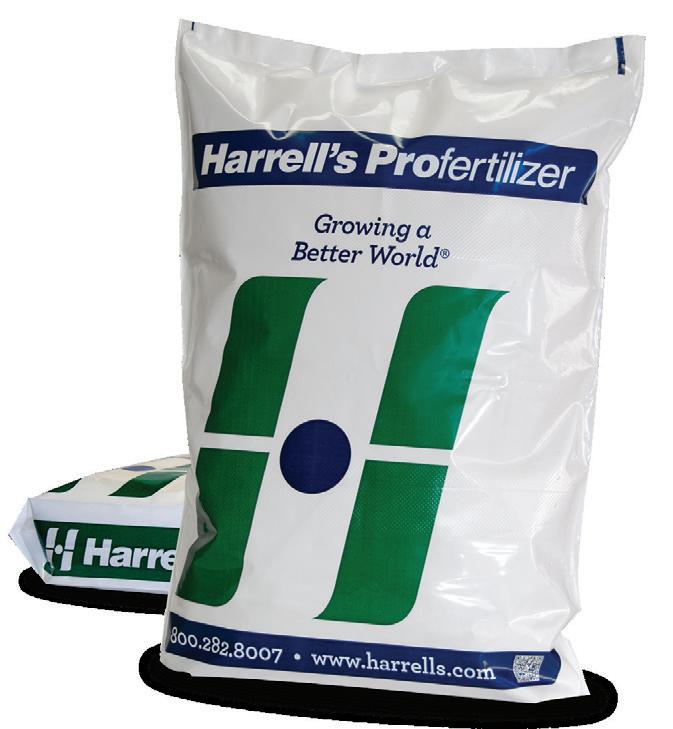

THE SIGN SAYS IT ALL!
The Turf Road Show continues to be a hit with members. The 2025 event was our best attended yet—77 in attendance. Fortunately, the weather cooperated since we had to change date from January to February because of bad weather.
The Lion Hills Center provides a great venue, and the food is always excellent. Thanks to Will Arnett, Director of Golf Operations and Program Instructor for Turf and Lawn Management, for hosting!
Our Educational Sessions are always top notch. The MSU Golf & Sports Turf Management was well represented with Drs. McCurdy, Stewart and Pudzianowska presenting current topics of interest to all attendees. Clarissa Balbalian, Plant Diagnostic Lab Director, told us how to avoid pitfalls of turf management problems and Russell Kohler with the MS Bureau of Plant Industry brought us up to date on recertification issues.
And, as always, thanks to our loyal supporters—pbi/GORDON for sponsoring lunch, Agra Turf, Inc., Envu, Greenpoint Pro, Harrell’s, Quali-Pro, Simplot, SurLine Turf and US Lawns.
The 2026 date is yet to be announced. •

President Scott Hampton welcomes attendees
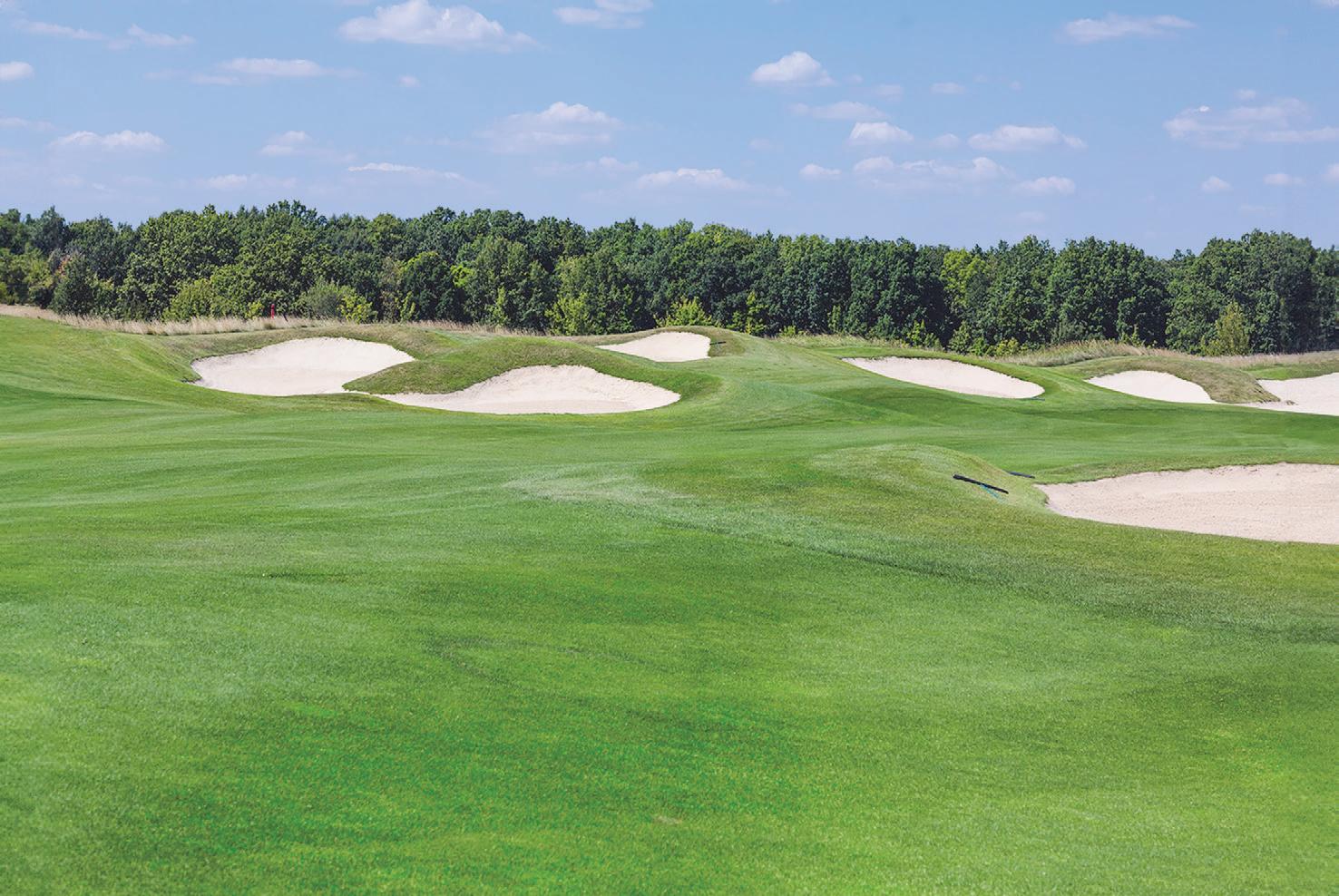



Mrs. Linda and the famous Lion Hills Lion surrounded by our sponsors: Left: Nick Wilson, Harrell’s—Mike Bounds—ENVU, Butch Pugh—Agra Turf, Inc, Scott Kuhn—Simplot. Scot is also Industry Rep on the MTA Board of Directors, Robb Webb—Greenpoint Pro.
5 Things Practitioners Should Know SURFACTANTS (OR WETTING AGENTS) SOIL
By
Rebecca Grubbs Bowling, Department of Plant Sciences, University of Tennessee, Knoxville, Tennessee USA
Zoe Haub Hinton, Department of Plant Sciences, University of Tennessee, Knoxville, Tennessee USA
Michael A. Fidanza, Pennsylvania State University –Berks Campus, Reading, Pennsylvania USA
Stanley J. Kostka, Pennsylvania State University –Berks Campus, Reading, Pennsylvania USA
Soil surfactants, commonly referred to by practitioners as “wetting agents”, can be useful tools for turfgrass managers. These products are traditionally applied to alleviate soil water repellency and localized dry spot, improve water movement through the soil profile, and enhance soil moisture uniformity. This article highlights select scientific findings and key considerations for end-users interested in utilizing these products in turfgrass and landscape management.
What Are Soil Surfactants?
A soil surfactant is essentially a “surface active agent” that reduces the surface tension of a liquid, thus allowing the liquid to interact with other liquids or solids (Zontek & Kostka, 2012). Most soil surfactant products marketed in the turfgrass industry are composed of block copolymers (Fidanza et al., 2020), which are constructed of both water-loving (hydrophilic) and water-repellent (hydrophobic) components. Simply put, they function to lower the surface tension of water and make hydrophobic soil particle surfaces “wettable”, thereby improving the interaction between the water and soil within the turfgrass rootzone (Kostka, 2000).
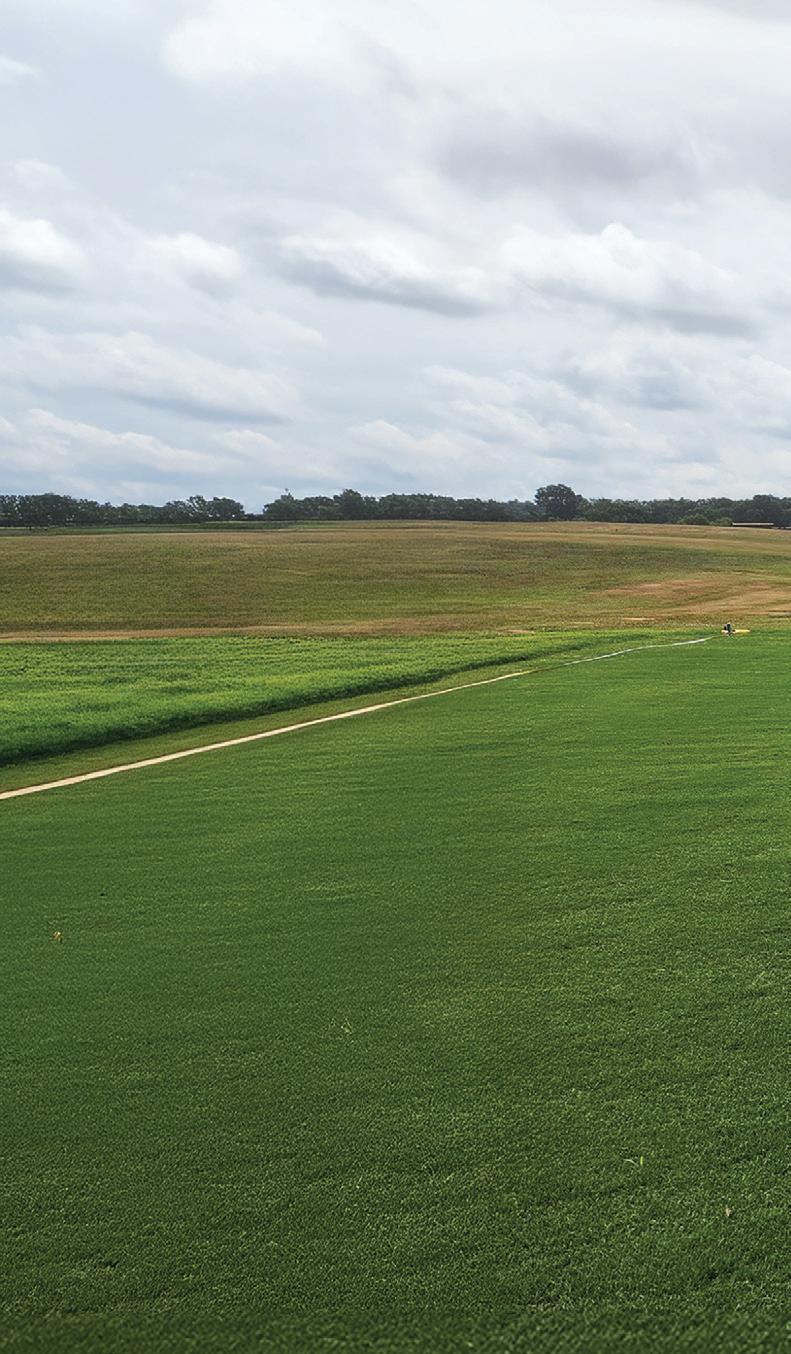
In turfgrass management, soil surfactants have long been used to address problems associated with soil water repellency (or soil hydrophobicity and localized dry spot (LDS) (Cisar et al., 2000; Dekker et al., 2005; Wilkinson and Miller, 1978). More recently, their role has expanded to general water management, including promoting water conservation and improving uniform water infiltration and distribution throughout the rootzone (Gelernter et al., 2015; Schiavon & Serena, 2023). This has also sparked interest in their effects on overall turfgrass quality and the placement and performance of other inputs like pesticides, fertilizers, and biostimulants. The growing use of soil surfactants is reflected in increased research on soil water repellency in turfgrass systems over the past two decades and the rising availability of products for consumers (Fidanza et al., 2020; Fidanza et al., 2023; Kostka & Fidanza, 2019; O’Brien et al., 2023; Whitlark, 2021).
Master’s student Zoe Haub Hinton laying out trials for fairway wetting agent research at the East Tennessee AgResearch and Education Center in Knoxville.
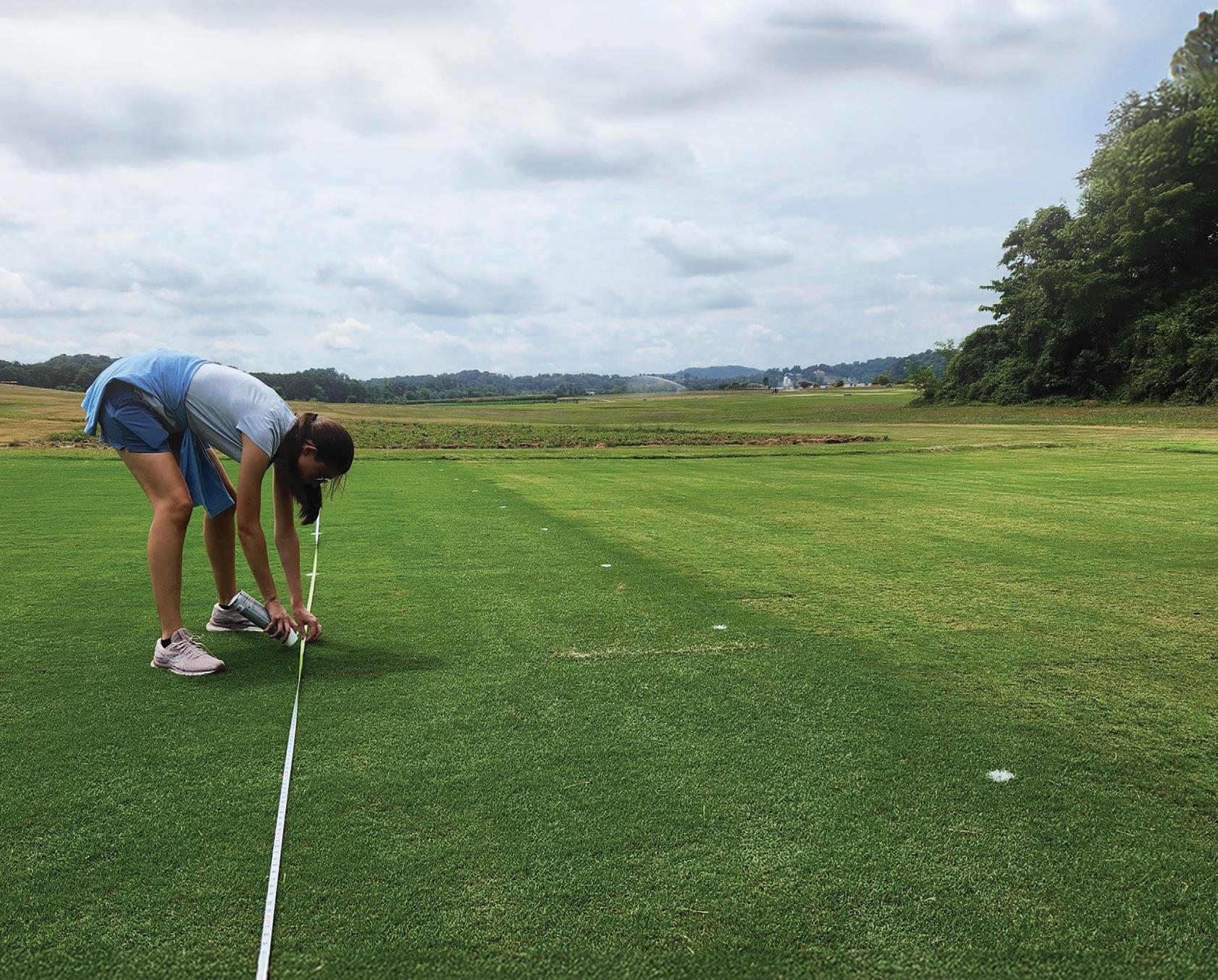
Key
Uses of Soil Surfactants in Turfgrass:
• ENHANCE WATER INFILTRATION: Alleviate soil water repellency.
• IMPROVE MOISTURE RETENTION AND UNIFORMITY: Promote consistent wetting across treated areas.
• SUPPORT WATER CONSERVATION: Can increase volumetric water content and reduce water waste by minimizing runoff and preferential flow.
What is hydrophobicity?
Hydrophobic soils develop due to the accumulation of organic compounds and biologically derived substances on soil particles (Cisar et al., 2000; Dekker & Ritsema, 2000; Kostka, 2000). Severe hydrophobic soil conditions are also associated with fairy ring occurrence in turfgrass sites (Fidanza et al., 2007). Overall, these hydrophobic or water repellent soil conditions are particularly problematic in sand-based rootzones, which are common in golf course putting greens, tee boxes, sand-capped fairways, and select athletic fields. Sandbased rootzones are more prone to hydrophobicity because the surface area of sand particles allows organic compounds to coat and interact with them more easily. Additionally, the rapid or frequent drying of sandier soils can impact microbial activity, limiting the natural breakdown of these substances.
Most research on soil surfactants focuses on golf course putting greens, but growing water challenges and affordable products are driving interest in using them for other turfgrass systems, especially in drought-prone areas facing summer or winter stress (Park et al., 2005; Schiavon & Serena, 2023; Whitlark et al., 2023).
Five Things Practitioners Should Know
1. Soil surfactants generally provide reliable water management benefits in sand-based rootzones, but their effectiveness in native or mineral soils is not as thoroughly investigated.
In sand-based rootzones, soil surfactants have been shown to effectively reduce hydrophobicity, mitigate LDS, and improve irrigation efficiency by enhancing water uniformity and increasing soil moisture (Bigelow et al., 2024; Dekker et al., 2019; Soldat et al. 2010). Research indicates that soil surfactants can support water conservation in sandy soils, particularly when irrigation or rainfall is limited, leading to improved turfgrass cover, quality, or both. On golf course putting greens, soil surfactants can offer additional benefits related to improving surface firmness and playability (Bauer et al., 2017).
Research on soil surfactants applied to turfgrasses maintained on native soils is limited but promising. One study showed that soil surfactants increased soil moisture by up to 16% and improved turfgrass quality, green cover, and soil moisture uniformity in deficit-irrigated hybrid bermudagrass (Cynodon dactylon x C. transvaalensis) fairways on mineral soil (Xiang et al., 2021). Similarly, studies in warm-season lawn environments showed that soil surfactants generally enhanced turfgrass quality and green cover, though results were sometimes inconsistent (Baliga et al., 2019; Chang et al., 2020). A recent study on fairway-height creeping bentgrass (Agrostis stolonifera L.) maintained on clay loam soil documented a 35 to 40% reduction of irrigation water quantity inputs achieved from soil surfactant-treated turfgrass (Nolan & Fidanza, 2024).
Overall, as soil and rootzone complexity increases, predicting the performance and benefits of soil surfactants becomes more difficult.
PRACTICAL RECOMMENDATIONS
These products may offer the most reliable benefits as a water management tool when:
1) soils are coarse-textured (sandy)
2) soil hydrophobicity is a known or reoccurring issue, and/or
3) water availability from rainfall or irrigation is limited
However, all turfgrass managers are encouraged to try these soil surfactant products to determine what may work well for them depending on their management resources and goals.
2. Understanding your unique site is important; Don’t rely solely on product language to make your selection
The increasing number and variety of soil surfactant products can make selection decisions overwhelming for end-users (Kostka & Fidanza, 2018). Two publicly available articles provide excellent insights on this topic: Communication of Soil Water Repellency Causes, Problems, and Solutions of Intensively Managed Amenity Turf from 2000 to 2020 by Drs. Mike Fidanza, Stanley Kostka, and Cale Bigelow, and Penetrants vs. Retainers: Understanding Wetting Agent Claims and the Science Behind Them by Dr. Daniel O’Brien et al., published by the USGA Green Section in 2023. Both articles discuss the nuances of soil surfactant use and selection.
In a nutshell, the marketing terms “penetrants” and “retainers” are often used to describe soil surfactant products. Penetrants claim to improve water infiltration by reducing soil water repellency, while retainers aim to keep moisture in the rootzone for sustained turfgrass hydration or soil water accessibility. However, it has been difficult for university and industry researchers to consistently replicate these marketing claims or perceptions in a field setting where environmental conditions and plant/soil interactions are more complex (Kostka & Fidanza, 2019, O’Brien et al., 2024).
Practitioners should also be aware that soil surfactant terminology or technical information is not standardized. Unlike pesticide labels regulated by the U.S. Environmental Protection Agency, soil surfactant labels are not federally regulated. Manufacturers are not required to disclose their full chemical composition or specific “active ingredient”, which limits transparency and can make it harder for university researchers to conduct comprehensive product evaluations. For example, many soil surfactant products will list ‘block copolymer’ on the product label, however, the exact composition may not be disclosed due to patent or proprietary protection.
Research suggests soil surfactant performance may or may not match marketing claims, and will depend most on application timing, post-application irrigation, soil type, turfgrass species, and environmental conditions.
PRACTICAL RECOMMENDATIONS
• Seek research-based information on a soil surfactant product to help with decision-making.
• Conduct your own evaluation on site to guide product selection.
° Assess performance using visual turfgrass quality or precise tools for soil moisture and surface firmness measurements.
° Test various products, application rates, and application timings to identify what works best for your specific conditions and expectations.
3. Soil surfactants can be a valuable addition to your winter management toolbox but should be combined with other best practices.
Winterkill is a recurring challenge for turfgrass managers across Tennessee, particularly for those managing warm-season turfgrasses. Contributing factors can include desiccation, or drying of turfgrass tissues, which can be worsened by soil hydrophobicity (Hutchens et al., 2024). Over the past two years, the combination of cold temperatures and drought conditions in many parts of Tennessee has increased the risk of desiccationrelated winterkill. While research on optimal soil moisture thresholds for winter management remains limited, studies conducted at the University of Arkansas and the University of Nebraska-Lincoln have explored the use of soil surfactants during colder months (DeBoer et al., 2019; DeBoer et al., 2020; Michael & Kreuser, 2020).
Findings suggest that soil surfactants can play a valuable role in a comprehensive winter management strategy that includes physical measures of covers or sand topdressing. Late-fall applications of soil surfactants may reduce soil hydrophobicity and, in some cases, enhance spring green-up. However, their effectiveness largely depends on environmental factors, such as rainfall and winter temperatures, and these products tend to show the most benefit during drier winters and are best used as a supplement to physical protection methods (DeBoer et al., 2019; DeBoer et al., 2020; Michael & Kreuser, 2020). Tailoring these approaches to site-specific conditions is essential for ensuring optimal turfgrass survival through the winter.
PRACTICAL RECOMMENDATIONS
• Soil surfactants can be applied in late fall to reduce soil hydrophobicity and retain soil moisture in problem areas.
• Focus on using soil surfactants in drier winters or desiccation-prone areas, adjusting application timing and rates to suite the needs of the turfgrass.
• Combine soil surfactant applications with covers or sand topdressing to enhance winter injury prevention.
4. Benefits of soil surfactants may extend to pest and nutrient management, but these relationships are not always straightforward and require further study.
Soil surfactants influence the effectiveness of fertilizers and pesticides in turfgrass by altering soil moisture and water movement or water interaction within the rootzone. Research shows that soil surfactants can enhance nutrient availability in the rootzone during dry periods by improving water infiltration, supporting turfgrass health under deficit irrigation (Chang et al., 2020), and impacting nitrogen availability and uptake (Abagandura et al, 2021; Dekker et al., 2019). Nitrogen mineralization is the biological process through which soil microbes decompose organic matter, converting it into
plant-available forms of nitrogen, such as ammonium (NH3-) and nitrate (NO4+). At least one study reported an increase in N mineralization and plant-available N which they attributed to more consistent moisture and a corresponding increase in microbial activity (Dekker et al., 2019). Another study found that surfactants applied with urea increase nitrogen uptake in bermudagrass with utilization rates rising by as much as 67% in sandy clay loam soils compared to urea alone (Abagandura et al., 2021). Soil surfactants can also be effective in managing Type-I fairy ring symptoms by reducing soil hydrophobicity attributed to fungal activity and enhancing fungicide penetration into the rootzone (Fidanza, 2015).
By addressing soil hydrophobicity, soil surfactants promote a more even water distribution and water receptivity of the rootzone, which reduces preferential flow paths where nutrients and pesticides might leach or run off. Thus, soil surfactant applications can improve the effectiveness of these inputs while lowering the risk of environmental harm. Several studies have found that soil surfactants meaningfully reduce nutrient leaching in hydrophobic, sand-based rootzones (Abagandura et al., 2021; Dekker et al., 2019; Aamlid et al., 2009; Larsbo et al., 2008). Two of these studies also showed that soil surfactants decreased fungicide leaching by as much as 80–90% in sand-based systems (Aamlid et al., 2009; Larsbo et al., 2008). Combining soil surfactants with organic amendments like peat may further reduce leaching by increasing soil absorption capacity (Larsbo et al., 2008).
However, newer research from North Carolina State University indicates these relationships are more complex and warrant further study. While soil surfactants improved fungicide movement into deeper soil layers, enhancing effectiveness against root-targeted diseases, different surfactant chemistries can influence fungicide behavior in varying ways. For example, some treatments even increased pesticide leaching, particularly under high rainfall conditions (Hutchens et al., 2020).
In more complex soil systems, the effects of soil surfactants may be less predictable. For example, a Texas study on nonhydrophobic sandy loam soils found that soil surfactants did not significantly reduce runoff or nutrient loss (Chang et al., 2020). However, an earlier California trial conducted on a wettable sandy loam, showed that surfactant treatment resulted in increased infiltration, wetting uniformity, and a reduction in runoff (Mitra et al, 2006). Additionally, research on soil microbial ecology suggests that prolonged soil surfactant use could alter microbial community structure, potentially affecting nutrient cycling and pesticide degradation, though much more research is needed in this area to determine their benefits or consequences to the soil and the rhizosphere (Banks et al., 2014; Carminati et al., 2016). Studies conducted in maize have provided some evidence that surfactants can have positive effects on soil microbiomes and nutrient cycling, improving nutrient availability (Ahmadi et al., 2018; Ahmadi et al., 2017). More research is needed in turfgrass.
• In drought-prone or hydrophobic areas, soil surfactants may improve nutrient availability and soil-directed pesticide placement.
• Consult researchers and monitor regularly if your site has higher risks of groundwater or surface water contamination.
• Take steps to stay up-to-date on research related to this topic, as it remains an understudied area where research is on-going globally.
5. THERE IS STILL A LOT WE DON’T KNOW.
While more soil surfactant products become available to consumers each year with growing suggestions for potential applications, there remain several knowledge gaps, of which many of have already been addressed by this article and are summarized below:
• HOW THEY WORK: More research is needed to further understand exactly how soil surfactant’s function or perform, their chemical composition, and how to select soil surfactant products that will provide the best benefit under different environments and turfgrass management practices. See O’Brien et al., 2024 for the first systematic evaluation of surfactant effects based on chemical composition.
• SOIL HEALTH OVER TIME: We do not fully know how long-term soil surfactant use affects soil microbes, nutrient cycling, or pesticide breakdown .See Abagandura et al and Ahmadi et al. whose research show positive effects on nutrients, soil microbes and nutrient cycling. This is a cutting-edge area.
• NATIVE SOILS: Most studies focus on sandy soils; more research is needed to see how soil surfactants perform with other soil types. See Mitra et al. 2006, Abagandura et al. 2021
• MIXING WITH OTHER INPUTS: There is limited understanding of how soil surfactants affect fertilizers and pesticides and biostimulants, including their movement or placement, persistence, and efficacy.
• COMBINING WITH AMENDMENTS: More studies are needed on how soil surfactants interact with peat or sand or other amendments typically utilized to improve soils.
• ENVIRONMENTAL IMPACT: We need better data on how soil surfactants impact ecosystems, especially in ecologically sensitive or high-risk areas.
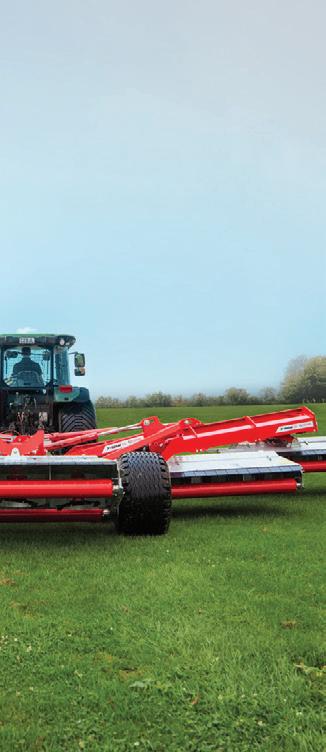


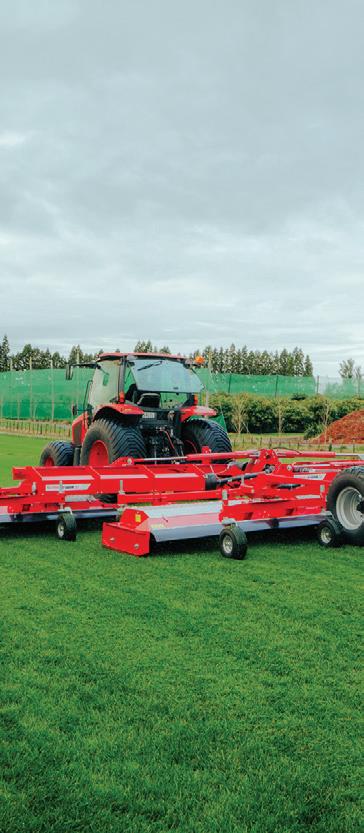







On-Going Research at the University of Tennessee
UT is conducting research independently and in collaboration with Dr. Travis Gannon at North Carolina State University to study soil surfactant interactions with native soils in the transition zone. Independent UT studies focus on seasonal impacts, while collaborative efforts, funded by the Golf Course Superintendents Association of America, examine soil surfactant effects on preemergence herbicide persistence and performance. Stay tuned for updates.
Conclusion
Soil surfactants represent a valuable tool and practice for improving or optimizing water management and water conservation, enhancing turfgrass quality, and addressing soil hydrophobicity. However, their effectiveness depends on proper selection, application timing, post-application irrigation, and integration into broader turfgrass management strategies. As research continues, turfgrass managers must remain adaptable and informed to maximize the benefits of these products.
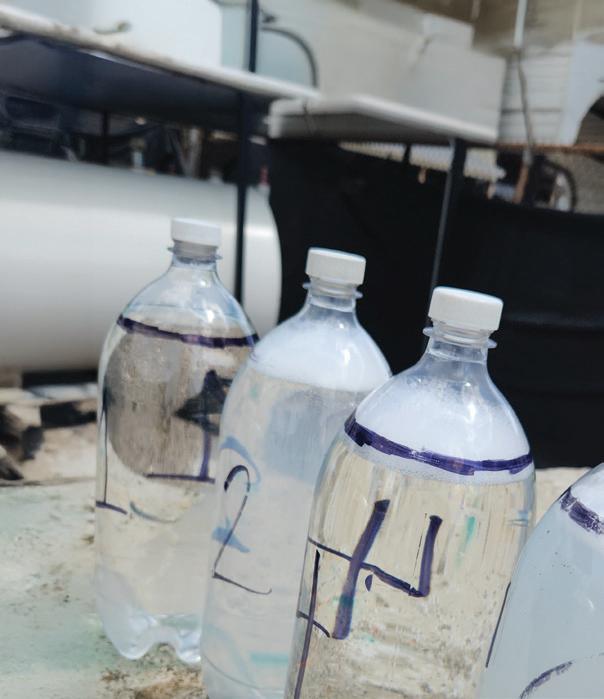














Soil surfactant (wetting agent) treatments used for on-going research at the University of Tennessee
REFERENCES
1. Aamlid, T. S., Larsbo, M., & Jarvis, N. (2009). Effects of surfactant use and peat amendment on leaching of fungicides and nitrate from golf greens. Biologia, 64(4), 419-423.
2. Abagandura, G. O., Park, D., Bridges Jr, W. C., & Brown, K. (2021). Soil surfactants applied with 15N labeled urea increase bermudagrass uptake of nitrogen and reduce nitrogen leaching. Journal of Plant Nutrition and Soil Science, 184(3), 378-387.
3. Ahmadi, K., Razavi, B. S., Maharjan, M., Kuzyakov, Y., Kostka, S. J., Carminati, A., & Zarebanadkouki, M. (2018). Effects of rhizosphere wettability on microbial biomass, enzyme activities, and localization. Rhizosphere, 7, 35-42.
4. Ahmadi, K., Zarebanadkouki, M., Ahmed, M. A., Ferrarini, A., Kuzyakov, Y., Kostka, S. J., & Carminati, A. (2017). Rhizosphere engineering: Innovative improvement of root environment. Rhizosphere, 3, 176-184.
5. Baliga, V. B., Young, J. R., & Carrillo, M. A. (2019). Evaluation of water retention products to conserve urban water resources in home lawns. Crop, Forage & Turfgrass Management, 5(1), 1-9.
6. Banks, M. L., Kennedy, A. C., Kremer, R. J., & Eivazi, F. (2014). Soil microbial community response to surfactants and herbicides in two soils. Applied Soil Ecology, 74, 12-20.
7. Bauer, S. J., Cavanaugh, M. J., & Horgan, B. P. (2017). Wetting agent influence on putting green surface firmness. International Turfgrass Society Research Journal, 13(1), 624-628.
8. Bigelow, C. A., Powlen, J. S., & Kostka, S. J. (2024). Localized dry spot recovery and water repellency in a sand golf green. In Sandy Soils (pp. 245-253). Cham: Springer Nature Switzerland.
9. Carminati, A., Zarebanadkouki, M., Kroener, E., Ahmed, M. A., & Holz, M. (2016). Biophysical rhizosphere processes affecting root water uptake. Annals of Botany, 118(4), 561-571.
10. Chang, B., Wherley, B., Aitkenhead-Peterson, J., Ojeda, N., Fontanier, C., & Dwyer, P. (2020). Effect of wetting agent on nutrient and water retention and runoff from simulated urban lawns. HortScience, 55(7), 1005-1013.
11. Cisar, J. L., Williams, K. E., Vivas, H. E., & Haydu, J. J. (2000). The occurrence and alleviation by surfactants of soil-water repellency on sand-based turfgrass systems. Journal of Hydrology, 231, 352-358. https://doi. org/10.1016/S0022-1694(00)00215-2
12. DeBoer, E. J., Richardson, M. D., McCalla, J. H., & Karcher, D. E. (2019). Reducing ultradwarf bermudagrass putting green winter injury with covers and wetting agents. Crop, Forage & Turfgrass Management, 5(1), 1-9.
13. DeBoer, E. J., Karcher, D. E., McCalla, J. H., & Richardson, M. D. (2020). Effect of late‐fall wetting agent application on winter survival of ultradwarf bermudagrass putting greens. Crop, Forage & Turfgrass Management, 6(1), e20035.
14. Dekker, L. W., Oostindie, K., Kostka, S. J., & Ritsema, C. J. (2005). Effects of surfactant treatments on the wettability of a water repellent grass-covered dune sand. Soil Research, 43(3), 383-395. https://doi. org/10.1071/SR04087
15. Dekker, L. W., & Ritsema, C. J. (2000). Wetting patterns and moisture variability in water repellent Dutch soils. Journal of Hydrology, 231, 148-164.
16. Dekker, L. W., Ritsema, C. J., Oostindie, K., Wesseling, J. G., & Geissen, V. (2019). Effects of a soil surfactant on grass performance and soil wetting of a fairway prone to water repellency. Geoderma, 338, 481-492.
17. Fidanza, M. A., Cisar, J. L., Kostka, S. J., Gregos, J. S., Schlossberg, M. J., & Franklin, M. (2007). Preliminary investigation of soil chemical and physical properties associated with type‐I fairy ring symptoms in turfgrass. Hydrological Processes, 21(17), 2285-2290.
18. Fidanza, M., Kostka, S., & Bigelow, C. (2020). Communication of soil water repellency causes, problems, and solutions of intensively managed amenity turf from 2000 to 2020. Journal of Hydrology and Hydromechanics, 68(4), 306-312. https://doi.org/10.1016/j.jhydrol.2020.02.004
19. Fidanza, M., Bigelow, C., Kostka, S., Ervin, E., Gaussoin, R., Rossi, F., Cisar, J., Dinelli, F. D., Pope, J., & Steffel, J. (2023). Advances in biostimulants in turfgrass. In M. Fidanza (Ed.), Achieving sustainable turfgrass management (pp. 469-504). Burleigh Dodds Science Publishing.
20. Gelernter, W. D., Stowell, L. J., Johnson, M. E., Brown, C. D., & Beditz, J. F. (2015). Documenting trends in water use and conservation practices on US golf courses. Crop, Forage & Turfgrass Management, 1(1), 1-10. https://doi.org/10.2134/cftm2014.0003.
21. Hutchens, W. J., Gannon, T. W., Shew, H. D., Ahmed, K. A., & Kerns, J. P. (2020). Soil surfactants influence fungicide movement in United States Golf Association putting green soil. Agronomy Journal, 49(2), 450-459.
22. Hutchens, W. J., Carr, T. Q., Patton, A. J., Bigelow, C. A., DeBoer, E. J., Goatley, J. M., & Xiang, M. (2024). Management strategies for preventing and recovering from bermudagrass winterkill. Crop, Forage & Turfgrass Management, 10(2), e20302.
23. Kostka, S. J. (2000). Amelioration of water repellency in highly managed soils and the enhancement of turfgrass performance through the systematic application of surfactants. Journal of Hydrology, 231, 359-368. https://doi.org/10.1016/S0022-1694(00)00216-4
24. Kostka, S. J., Cisar, J. L., Mitra, S., Park, D. M., Ritsema, C. J., Dekker, L. W., & Franklin, M. A. (2007). Irrigation efficiency. Soil surfactants can save water and help maintain turfgrass quality. Golf Course Industry, 2007, 91-95.
25. Kostka, S., & Fidanza, M. (2018). The quagmire that is soil surfactants in golf and sports turf management. In ASA, CSSA and SSSA International Annual Meetings (p. 113267). Agronomy Abstracts
26. Kostka, S., & Fidanza, M. (2019). Soil surfactant usage based on solid science. Golf Course Industry Retrieved from https://www.golfcourseindustry.com/article/soil-surfactant-research-guidance/
27. Larsbo, M., Aamlid, T. S., Persson, L., & Jarvis, N. (2008). Fungicide leaching from golf greens: Effects of root zone composition and surfactant use. Journal of Environmental Quality, 37(4), 1527-1535.
28. Michael, D. J., & Kreuser, W. C. (2020). Sand topdressing and protective covers impact creeping bentgrass crown moisture during winter. Agronomy Journal, 112(2), 1452-1461.
29. Mitra, S., Vis, E., Kumar, R., Plumb, R., & Fam, M. (2006). Wetting agent and cultural practices increase infiltration and reduce runoff losses of irrigation water. Biologia, 61(19), S353-S357.
30. Nolan, G., & Fidanza, M. (2024). Evaluation of two soil surfactants for soil water management of creeping bentgrass on a wettable clay loam rootzone during an imposed dry-down period. Journal of Environmental Horticulture, 42(1), 40-45.
31. O’Brien, D., Fidanza, M., Kostka, S., & Richardson, M. (2023). Penetrants vs. retainers: Understanding wetting agent claims and the science behind them. USGA Green Section Record, 61(10). Retrieved from https://www.usga.org/content/usga/home-page/course-care/green-section-record/61/issue-10/penetrantsvs-retainers-understanding-wetting-agent-claims-and.html
32. O’Brien, D., Richardson, M., Kostka, S., & Karcher, D. (2024, April). Examining the structure-function relationship of block copolymer soil surfactants in sand-based putting greens. In 42nd Symposium on Pesticide Formulation and Delivery Systems: Building the Future of Agrochemicals for 2030 and Beyond (pp. 61-80). ASTM International.
33. Park, D. M., Cisar, J. L., McDermitt, D. K., Williams, K. E., Haydu, J. J., & Miller, W. P. (2005). Using red and infrared reflectance and visual observation to monitor turf quality and water stress in surfactant-treated bermudagrass under reduced irrigation.
34. Schiavon, M., & Serena, M. (2023). Advances in irrigation and water management of turfgrass. In M. Fidanza (Ed.), Achieving sustainable turfgrass management (pp. 157-196). Burleigh Dodds Science Publishing.
35. Soldat, D. J., Lowery, B., & Kussow, W. R. (2010). Surfactants increase uniformity of soil water content and reduce water repellency on sand-based golf putting greens. Soil Science, 175(3), 111-117.
36. Whitlark, B. (2021). Five proven methods to improve moisture uniformity. USGA Green Section Record, 59(12). Retrieved from https://www.usga.org/content/usga/home-page/course-care/green-section-record/59/12/five-proven-methods-to-improve-moisture-uniformity.html
37. Wilkinson, J. F., & Miller, R. H. (1978). Investigation and treatment of localized dry spots on sand golf greens. Agronomy Journal, 70(2), 299-304. https://doi.org/10.2134/agronj1978.00021962007000020013x
38. Xiang, M., Schiavon, M., Orlinski, P., Forconi, A., & Baird, J. H. (2021). Identification of wetting agents for water conservation on deficit‐irrigated hybrid bermudagrass fairways. Agronomy Journal, 113(5), 3846-3856.
39. Zontek, S. J., & Kostka, S. J. (2012). Understanding the different wetting agent chemistries. Green Section Record, 50(15), 1-6. •
Agra Turf, Inc. ........................................ 17 www.agrainc.com
Beard Equipment 3 www.beardequipment.com
Greene County Fertilizer Co. 17 www.greenecountyfert.com
Harrell’s LLC Back Cover www.harrells.com
Jackson Sand.......................................... 11 www.jacksonsand.com
Jerry Pate Turf & Irrigation Inside Back Cover www.jerrypate.com
Leading Edge Communications 9 www.LeadingEdgeCommunications.com
Progressive Turf Equipment Inc. 5 www.progressiveturfequip.com
Regal Chemical Company Inside Front Cover www.regalchem.com
Riebeling Farms, Inc. 19 riebelingfarmsinc@gmail.com
Smith Seed Services 17 www.smithseed.com
Sur-Line Turf, Inc. .................................. 19 www.surlineturf.com
The Aquatrols Company 5 www.aquatrols.com
Trimax Mowing Systems 16 www.trimaxmowers.com
The Turf Zone 21 wwww.theturfzone.com

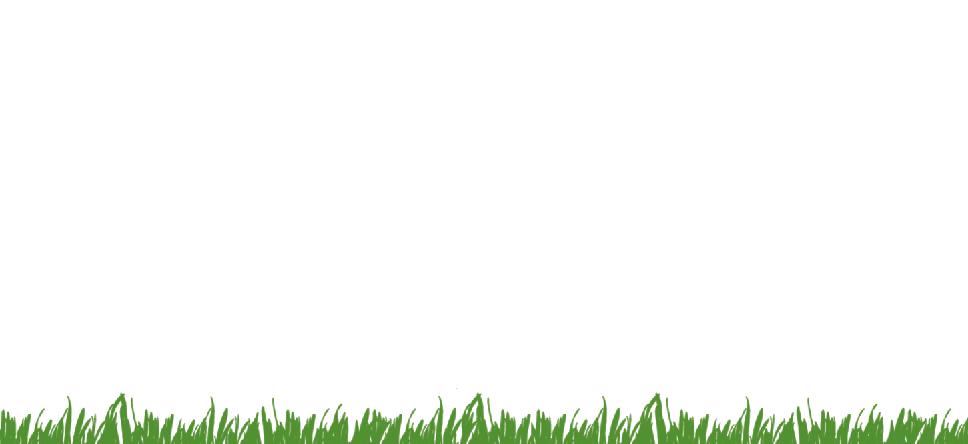
THE BUSINESS BEHIND THE GREEN
FOR HOW TO SERVICES PRICE YOUR PROFIT
By Kristina Kelly

When it comes to running a turfgrass business, your work is rooted in results. Healthy lawns, properly installed sod, and satisfied customers are the visible signs of success. And behind every vibrant blade of grass is a business owner making daily decisions that impact their bottom line. One of the most important? Pricing.
Setting the right price for your services can feel like trying to hit a moving target. Charge too little, and you’re leaving money on the table or risking your ability to sustain operations. Charge too much, and you might struggle to stay competitive in your market. Whether you’re a seasoned professional or new to the industry, understanding how to price your services for profit is key to long-term stability and growth.
Know Your True Costs
Before setting any price, you need to understand what it actually costs to deliver your services. That means looking beyond just materials and labor. Your total cost should include direct and indirect expenses, such as:
• Labor wages, including payroll taxes and workers’ compensation
• Equipment maintenance, fuel, and depreciation
• Material costs, like sod, seed, fertilizer, and irrigation supplies
• Insurance, licenses, and permits
• Office overhead, marketing, and administrative costs
If you’re only calculating based on materials and hourly labor, you may be unintentionally operating at a loss. Developing a simple spreadsheet or using job-costing software can help you track these figures and understand your cost per service. This step lays the foundation for profitable pricing.
Factor in Your Desired Profit Margin
Once you know your costs, it’s time to add your profit margin. This isn’t greedy. It’s necessary. Profit allows you to reinvest in your business, build a financial cushion, and pay yourself a fair wage as the owner. A healthy net profit margin in service industries typically ranges from 10 to 20 percent, though it may vary based on your service mix and market.
For example, if it costs you $2,000 to complete a sod installation job, and you want a 20 percent profit margin, your price should be at least $2,500. Many business owners make the mistake of only charging enough to cover costs, which can lead to financial stress or burnout down the road.
Understand the Market (But Don’t Let It Dictate Your Value)
Knowing what competitors charge is important, but it shouldn’t be your only reference point. Pricing strictly to match or undercut
the competition can turn into a race to the bottom. Instead, use market research to understand the range of prices in your area, and then position yourself based on the value you provide.
If your work is high quality, your team is reliable, and you offer responsive customer service, you don’t need to be the cheapest option. Instead, you can charge what you’re worth and attract customers who recognize and value professionalism. That might mean saying no to some price-sensitive clients, but it will help you build a stronger, more sustainable client base in the long run.
Avoid the Temptation of Flat-Rate Guesswork
It can be tempting to offer flat-rate pricing to simplify your quotes, but this approach can backfire if it’s not backed by data. Every job is different, and variables like square footage, site conditions, soil prep, and access points can dramatically affect your costs. If you rely on gut instinct or round numbers to quote jobs, you may end up underbidding without realizing it.

Instead, develop a pricing model based on per-square-foot or per-hour rates that can be customized to each job. This approach also helps you educate your clients and show transparency in your pricing.
Build in a Buffer for Risk and Rework
Not every job goes according to plan. Weather delays, equipment breakdowns, and last-minute client changes can eat into your profitability. When calculating your price, include a small buffer to account for the unexpected. This might be an extra percentage added to your labor costs or a built-in contingency fee.
Additionally, consider how you’ll handle rework or warranty issues. If you offer a guarantee on sod establishment or turf health, make sure that’s reflected in your pricing structure. It’s better to plan for these scenarios than to absorb the cost later.
Review and Adjust Regularly
Your pricing shouldn’t be static. Costs increase over time, and so should your rates. Review your pricing annually (or more frequently if you experience major changes in labor or material costs). Communicate price increases clearly and professionally with clients and reinforce the value they receive. Most customers understand that inflation and industry dynamics affect pricing, especially if they trust the quality of your work.
Regular reviews can also help you identify services that may no longer be profitable, or spot opportunities to package offerings in a way that increases revenue.
Package and Upsell Strategically
One way to boost profitability is by offering bundled services or strategic upsells. For example, if you’re installing sod, you could offer irrigation system checks, soil testing, or seasonal fertilization packages. These added services not only increase the overall value of a job, but they also help position your business as a comprehensive turf solution provider.
Clients often appreciate a “one-stop shop” approach, especially when it simplifies their to-do list and increases the success of their lawn or landscape investment.
Know When to Walk Away
Finally, remember that not every job is the right fit. If a prospective client pressures you to lower your price or match a competitor’s rate without understanding the difference in service quality, it may be best to politely walk away. Saying no to low-margin
work frees up your time and resources for jobs that are actually profitable.
It takes confidence and discipline, but walking away from the wrong clients is just as important to your bottom line as securing the right ones.
Pricing Done Right
Pricing is one of the most important decisions you make as a turfgrass professional and business owner. It requires a clear understanding of your costs, an honest evaluation of your value, and the willingness to protect your profit margins. When done right, pricing becomes more than a number on a quote—it becomes a reflection of your professionalism and the foundation of a thriving business.
By taking a thoughtful, data-driven approach to pricing, you’ll not only ensure the health of your business but also earn the trust and loyalty of clients who see the value in what you do. •





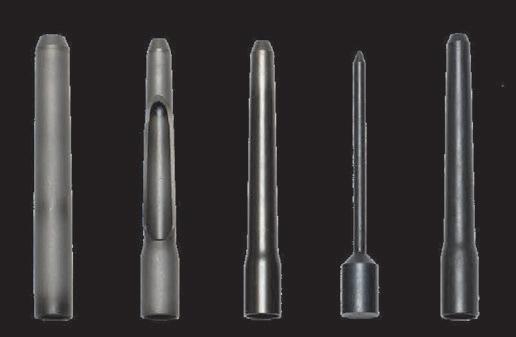


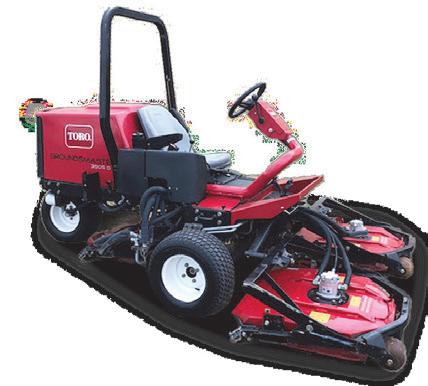





POLYON® Controlled-Release Fertilizer. Success. Guaranteed.
For more than 30 years, POLYON® Fertilizer’s durable, unique bonded coating process has been ensuring predictable results you can depend on - we guarantee it!
For more information about POLYON® Fertilizer and the POLYON® Guarantee, visit ww w.polyon.com or contact your sales representative today!

NICK WILSON
Golf- Mississippi nwilson@harrells.com (601) 323-5035

BRETT DRINKWINE
Golf- Gulf Coast bdrinkwine@harrells.com (251) 689-3288

JAMES BARTLEY
Turf & Landscape- Mississippi jbartley@harrells.com (334) 707-5134
